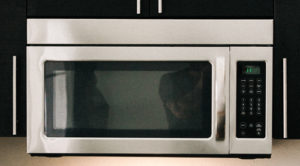I remember the first microwave we had in our house. It was the mid-70’s and my Dad worked for a company called Winchester Electronics based in Watertown, Connecticut. I have no idea if they’re still around, but one of their biggest consumer product lines was microwave ovens. Since he worked for the company he got one at a steep discount for about $550, which was a fortune back then.
 Microwaves have come a long way, but ultimately they haven’t changed that much. The principle is still essentially the same. They use radiation to manipulate the food at the molecular level, making them vibrate by the short radio waves emitted into the food. The vibration creates energy which heats up the food. This is why the food cooks quickly — because all the molecules on the inside are cooking at the same time as the ones on the outside, unlike conventional heat which starts on the surface and makes its way inside the food.
Microwaves have come a long way, but ultimately they haven’t changed that much. The principle is still essentially the same. They use radiation to manipulate the food at the molecular level, making them vibrate by the short radio waves emitted into the food. The vibration creates energy which heats up the food. This is why the food cooks quickly — because all the molecules on the inside are cooking at the same time as the ones on the outside, unlike conventional heat which starts on the surface and makes its way inside the food.
So that’s all I’m gonna say about how microwave cooking works. Now I want to talk about why you might want to avoid using them, or at least minimize their use.
Microwaved Food Doesn’t Taste as Good
Microwaved food just doesn’t taste as good as conventionally cooked food. This may sound a bit like my personal opinion, and that’s because it is. But try it for yourself. I challenge you to reheat two portions of a leftover meal: one portion in a microwave and one the way the food was cooked originally (pan or oven) and taste for yourself.
Microwaves May Release Radiation Into the Environment
The amount of radiation that a microwave emits into your home depends on two factors: the quality of the microwave itself and how often you use it. The FDA has established safety guidelines that require microwave ovens to emit less than “5 milliwatts of radiation per square centimeter” which must be in a field of less than 2 inches from the oven. And this guideline is over the lifetime of the machine. So in general this seems like a pretty safe amount and as long as you don’t use the microwave for everything, and stick your face against the glass to watch it cook, this is probably not much of a danger.
Microwaves Release Radiation Into the Food
This factor is of much higher concern (IMO of course). There’s a TON of conflicting evidence on how much radiation is retained by the cooked food, and how much that radiation affects the nutritional properties of the food. Some articles I’ve read state microwaving certain foods are healthier because the food retains more of its nutrition due to being cooked quickly. However other studies prove that some foods tested after being microwaved had less nutrition than their conventionally cooked counterparts. So when you have two sets of studies that report opposite results, I’d take the safe route and assume the worst.
There Are Better Ways to Reheat Food
Microwaves are fast, yes, but with a little advance planning there’s a better, safer way. You can reheating a plate of leftovers in a toaster oven in about 20 minutes. The only downside is you have to think ahead a little. Set the plate in the oven, put it at 200 degrees F and set your timer. If you’re reheating four plates of leftovers then do it in your regular oven. Done. No messy scary plastic wrap, no radiation in your food.
Here’s an article from The Kitchn that talks about the best ways to reheat foods.
